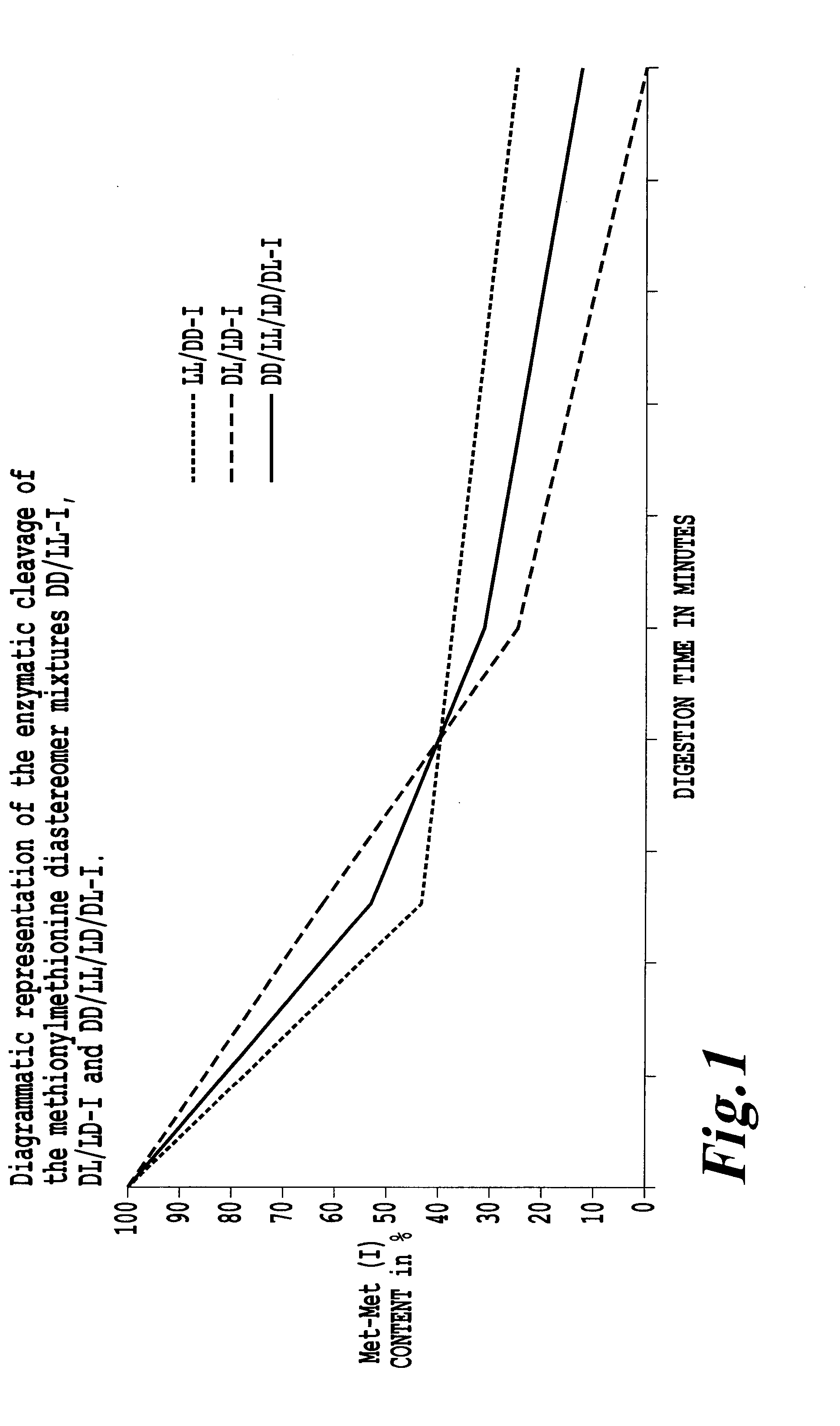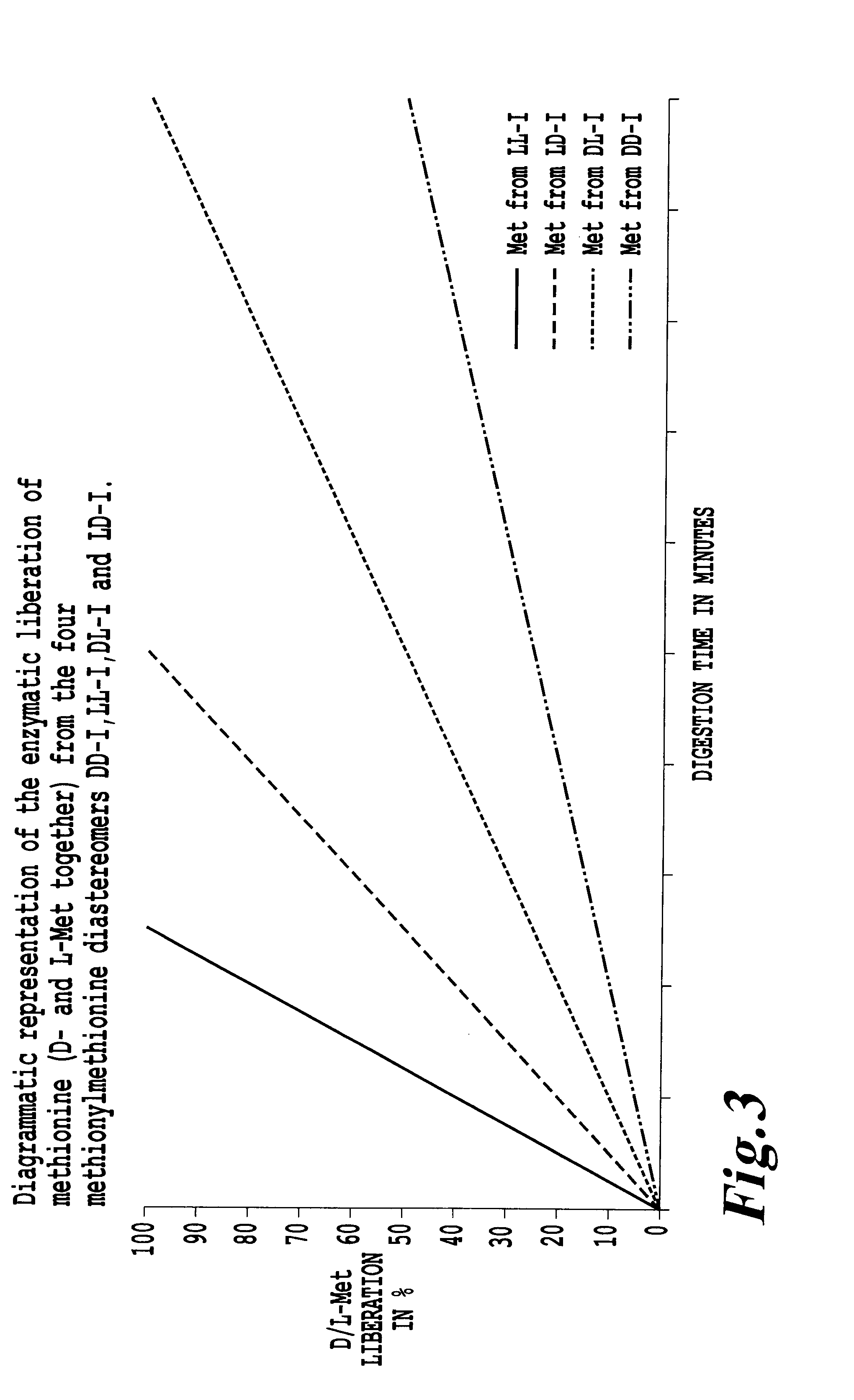Preparation and use of methionylmethionine as feed additive for fish and crustaceans
a technology of methionylmethionine and fish, which is applied in the field of preparation and use of methionylmethionine as feed additive for fish and crustaceans, can solve the problems of further problems in crustaceans, use of methionine, mha, and cost and elaborate,
- Summary
- Abstract
- Description
- Claims
- Application Information
AI Technical Summary
Benefits of technology
Problems solved by technology
Method used
Image
Examples
example 1
Synthesis of 3,6-bis[2-(methylthio)ethyl]-2,5-piperazinedione (III) (methioninediketopiperazine, DKP) from N-carbamoylmethionine (IIa) by method A
[0105]17.5 g (90.0 mmol, purity: 99%) of N-carbamoylmethionine (IIa) were dissolved in 150 ml of water and stirred in a 200 ml Roth steel autoclave with magnetic stirring at 160° C. for 6 hours. The pressure increased during this period. From time to time, gas was repeatedly discharged until a pressure of 7 bar was reached. After completion of the reaction, the autoclave was cooled in an ice bath. The resulting suspension was then filtered, and the filtered solid was washed several times with water and dried in a drying oven at 50° C. in vacuo. The isolated yield was 8.1 g (30.9 mmol) (69%) of bis[2-(methylthio)ethyl]-2,5-piperazinedione (III), yellowish white crystals, purity>98% (HPLC), melting point 234-236° C.
[0106]1H-NMR of 3,6-bis[2-(methylthio)ethyl]-2,5-piperazinedione (III) (500 MHz, D6-DMSO): δ=1.85-2.05 (m, 4H, 2×SCH2CH2); 2.049...
example 2
Synthesis of 3,6-bis[2-(methylthio)ethyl]-2,5-piperazinedione(III) (methioninediketopiperazine, DKP) from 2-[(aminocarbonyl)amino]-4-(methylthio)butanoamide (N-carbamoylmethioninamide) (IIb) by method A
[0109]17.4 g (90.0 mmol, purity: 98.5%) of 2-[(aminocarbonyl)amino]-4-(methylthio)butanoamide (IIb) were dissolved in 150 ml of water and stirred in a 200 ml Roth steel autoclave with magnetic stirring at 160° C. for 7 hours. The pressure increased during this heating. From time to time, gas was repeatedly discharged until a pressure of 7 bar was reached. After completion of the reaction, the autoclave was cooled in an ice bath. The resulting suspension was then filtered, and the filtered solid was washed several times with water and dried in a drying oven at 50° C. in vacuo. The isolated yield was 9.2 g (35.1 mmol) (78%) of bis[2-(methylthio)ethyl]-2,5-piperazinedione(III), yellowish white crystals, purity>98% (HPLC).
[0110]The melting point and the NMR data agreed with those of exam...
example 3
Synthesis of 3,6-bis[2-(methylthio)ethyl]-2,5-piperazinedione(III) (methioninediketopiperazine, DKP) from 5-[2-(methylthio)ethyl]-2,4-imidazolidinedione (IId) (methioninehydantoin) by method A and subsequent reuse of the mother liquor (cascade reaction)
[0111]First Batch:
[0112]A suspension of 13.4 g (0.09 mol) of methionine, 17.2 g (0.09 mol, purity: 91%) of methioninehydantoin (IId) and 150 g of water were introduced into a 200 ml Roth steel autoclave with magnetic stirring and stirred at 160° C. for 6 hours, during which the pressure increased to 15 bar. From time to time, the autoclave was decompressed until the pressure settled at a constant 10 bar. The autoclave was then cooled in an ice bath, and the resulting suspension was filtered and the solid was washed with 75 ml of water. Finally, the solid was dried in a vacuum drying oven at 50° C. overnight. Bis[2-(methylthio)ethyl]-2,5-piperazinedione (III) was isolated as yellowish white crystals.
[0113]Subsequent Batches:
[0114]The ...
PUM
| Property | Measurement | Unit |
|---|---|---|
| temperature | aaaaa | aaaaa |
| pressure | aaaaa | aaaaa |
| temperature | aaaaa | aaaaa |
Abstract
Description
Claims
Application Information
 Login to View More
Login to View More - R&D
- Intellectual Property
- Life Sciences
- Materials
- Tech Scout
- Unparalleled Data Quality
- Higher Quality Content
- 60% Fewer Hallucinations
Browse by: Latest US Patents, China's latest patents, Technical Efficacy Thesaurus, Application Domain, Technology Topic, Popular Technical Reports.
© 2025 PatSnap. All rights reserved.Legal|Privacy policy|Modern Slavery Act Transparency Statement|Sitemap|About US| Contact US: help@patsnap.com



